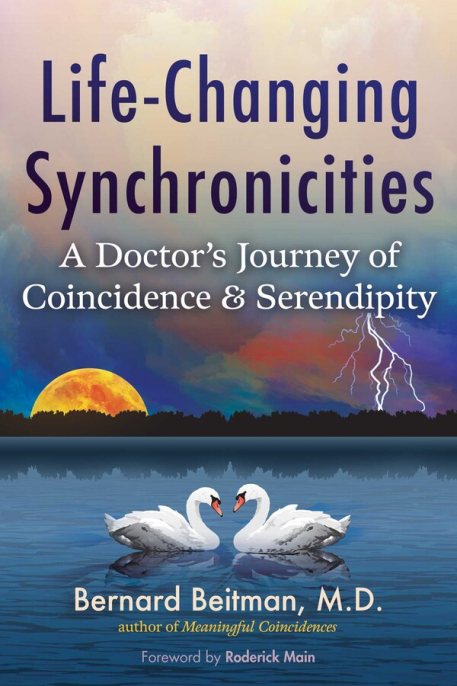
Reviewed by Peter A. McCue
Bernard Beitman is the author of two previous books on ‘meaningful coincidences’ (Beitman, 2016, 2022). His 2022 book was reviewed by Laurence Browne in the April 2024 issue of the Journal of the SPR.
Born in Detroit, Michigan, in 1942, Beitman is of German Jewish descent. Some of his relatives were murdered by the Nazis. He did well at school. After graduating from Swarthmore College in Pennsylvania, he went on to Yale Medical School. In the summer of 1965, after his first year at Yale, he had an LSD experience in Los Angeles. After graduating from Yale, Beitman moved to California, where he did his medical internship and psychiatric training, and where he served his two years of military service at a hospital in San Francisco. While in California, he fraternised with members of San Francisco’s hippy scene. Despite this somewhat unconventional background, he eventually became chair of psychiatry at the University of Missouri-Columbia. Beitman now lives in Virginia.
Beitman’s outlook is decidedly ‘New Age’. For example, he appears to believe in reincarnation (p. 28), and he thinks that each of us has a ‘bioenergetic field’ and that it’s possible, intuitively, to read information contained in such fields (pp. 112-3). He also believes that it’s possible for humans to communicate with trees (Chap. 19).
Life-Changing Synchronicities has an autobiographical focus, with a particular emphasis on synchronistic events in Beitman’s own life. (I’ve cited some examples below.) After a foreword by Roderick Main, a British-based academic with an interest in Jungian psychology, there’s an introductory section by Beitman, and then twenty-two chapters. They’re followed by an epilogue and three appendices. The book ends with an acknowledgements section and a bibliography. There’s a scattering of black and white photos throughout the book. Unfortunately, though, it lacks an index.
Carl Gustav Jung (1875-1961), the Swiss psychiatrist who introduced the term synchronicity, conceived of the process as being acausal (Jung, 1952/1972). But some people use the expression without insisting that meaningful coincidences necessarily have no cause. Beitman, for example, states that some of the meaningful coincidences that he’s experienced “may have been orchestrated by spirit guides” (p. 5).
Author and researcher Christopher O’Brien had a synchronistic experience that left him convinced that a tricksterish and paranormal energy, force, or entity can manipulate coincidence and create synchronicity. The incident is mentioned in at least three of his books (O’Brien, 2007, pp. 100-103; 2009, pp. 69-73; 2014, pp. 292-294). He explains that in 1993, he spoke to members of a family called Sutherland about a bull of theirs that had been found dead and mutilated in June 1980. The previous evening, they’d heard a helicopter flying slowly south over their property. Then, 15-20 minutes later, they heard it again and saw it rising from the pasture where the dead bull would be found the following morning. It was of a mustard-yellow colour, looked old-fashioned, and seemed to lack any markings. It flew back over the family’s house, in a northerly direction. Despite making extensive enquiries, they were unable to discover where it had come from. They were told that a helicopter of that type would be extremely rare and would be highly expensive to keep airworthy. The day after he visited the Sutherlands – that is, some 13 years after the aforementioned incidents – O’Brien was at home, reviewing and typing up his interview notes, when he heard, and then saw, a helicopter that matched what the Sutherlands had seen in 1980. There were also other witnesses to the sighting.
Returning to Beitman’s book, he cites an incident involving himself and one of his psychotherapy patients (pp. 114-5). He’d bought a pair of blue-framed glasses, thinking they were “cool”. Beitman put them on, with his back to the patient, who had just entered his room. He turned round to surprise her, and for the first time in some 20 sessions, she was also wearing glasses. Normally, she didn’t like to wear them, but on this occasion, she had felt an urge to do so. The incident amused them, and they spent some time discussing the meaning of the coincidence. They concluded that it meant that they were “seeing eye to eye”.
Perhaps the most dramatic coincidence that Beitman mentions relates to a night in late February 1973 (pp. 75-6). At the time, he was 31 and living in a house in San Francisco. He was standing by the kitchen sink and then found himself bent over it and choking uncontrollably. Something seemed to have become caught in his throat, but he couldn’t cough it up, and he hadn’t eaten anything. After about 15 minutes, he was able to swallow and breathe normally. The next day, he learned that his father, 3,000 miles away in Delaware, had died. He’d apparently experienced bleeding into his throat, which caused him to choke on his own blood. The two events – Beitman’s experience and his father’s choking – had occurred more or less simultaneously. Beitman inferred that the “message” to him was to remember his loving connection with his father, and “to get seriously curious” about how the coincidence might have occurred.
The reports cited in Beitman’s book don’t wholly involve himself. For example, he mentions the wife of one of his patients (p. 148). She was driving alone in her car and, while turning onto another road, she took the left lane as indicated. However, a strong voice, seemingly from someone within the car, commanded her to get into the right lane. She did so, which saved her from a collision with a truck that was barrelling through the intersection. Of course, from a traditional psychical research standpoint, this incident, and the one involving Beitman’s father, might be construed in terms of ESP rather than synchronicity.
Unfortunately, I don’t find Beitman’s writing entirely clear. For example, he states that the brain “is wired for fast nonconscious deliberate action” (p. 201). Arguably, though, a “deliberate action” is one that’s consciously made. Even more opaquely, he contends that, “Your individuating uniqueness defines the limitations that provide you with a sense of existing” (p. 207). At points in the book, he refers to his participation in team sports such as baseball and American football. To someone unfamiliar with these games, his jargon might seem impenetrable. For instance, he reports that he “got seventeen hits out of thirty-five at bats my junior year, seven of which were drag bunts” (p. 29).
Irrespective of whether one agrees with Beitman’s inferences about the incidents he reports, the anecdotes are of interest in their own right.
References
Beitman, B. (2016). Connecting with coincidence: The new science for using synchronicity and serendipity in your life. Health Communications.
Beitman, B. (2022). Meaningful coincidences: How and why synchronicity and serendipity happen. Park Street Press.
Jung, C. G. (1972). Synchronicity: An acausal connecting principle. Routledge & Kegan Paul. (Original work published in 1952)
O’Brien, C. (2007). Secrets of the mysterious valley. Adventures Unlimited Press.
O’Brien, C. (2009). Stalking the tricksters: Shapeshifters, skinwalkers, dark adepts and 2012. Adventures Unlimited Press.
O’Brien, C. (2014). Stalking the herd: Unraveling the cattle mutilation mystery. Adventures Unlimited Press.

